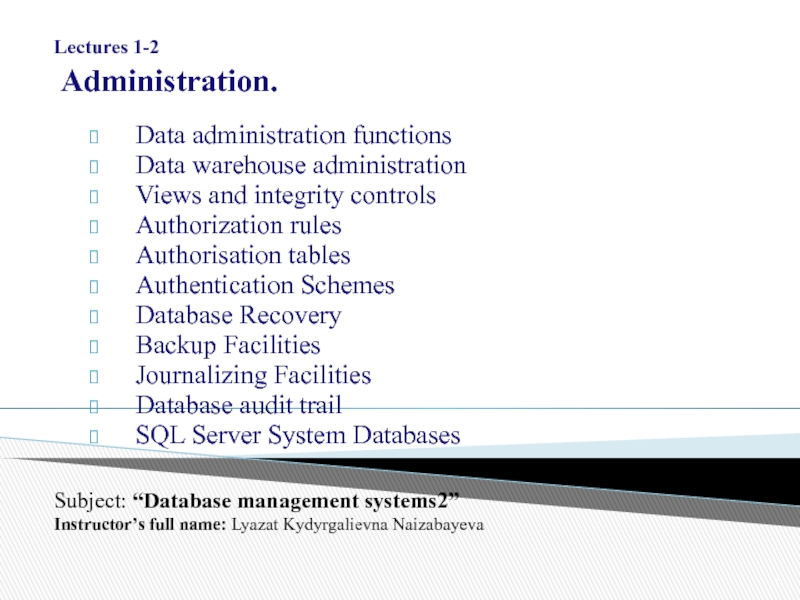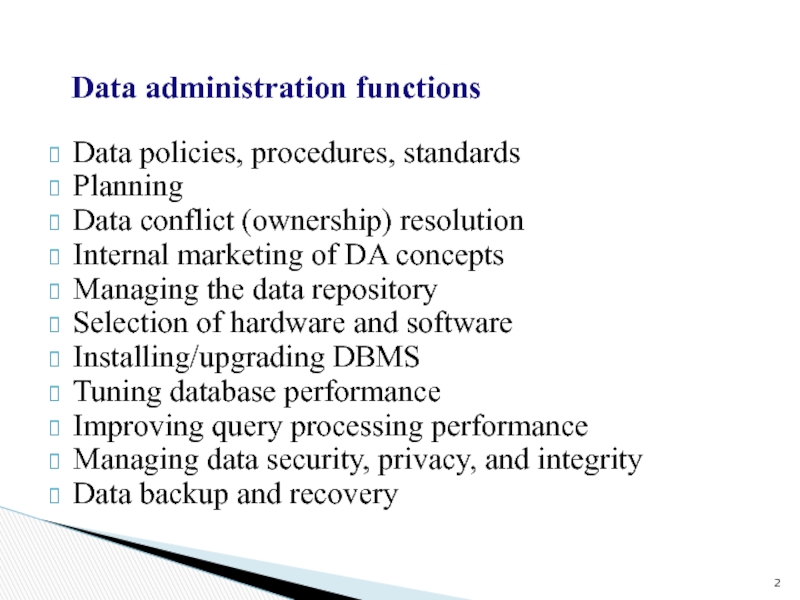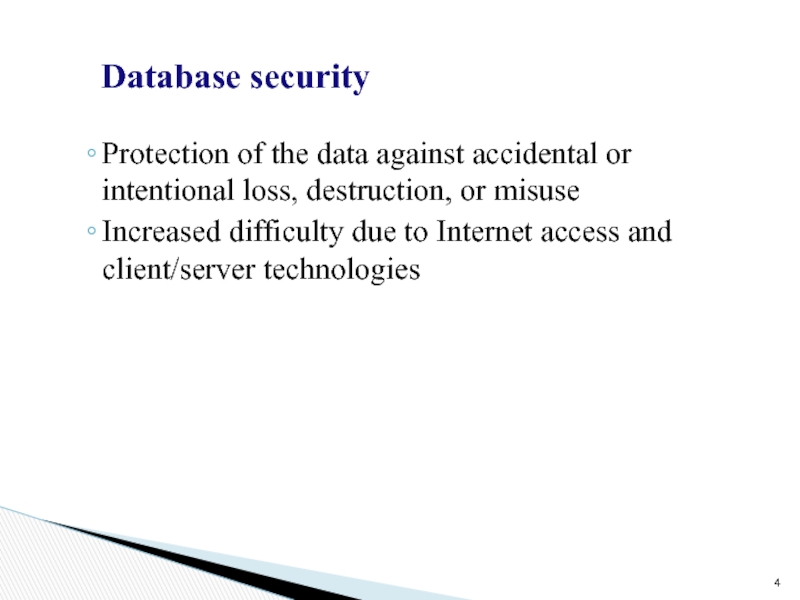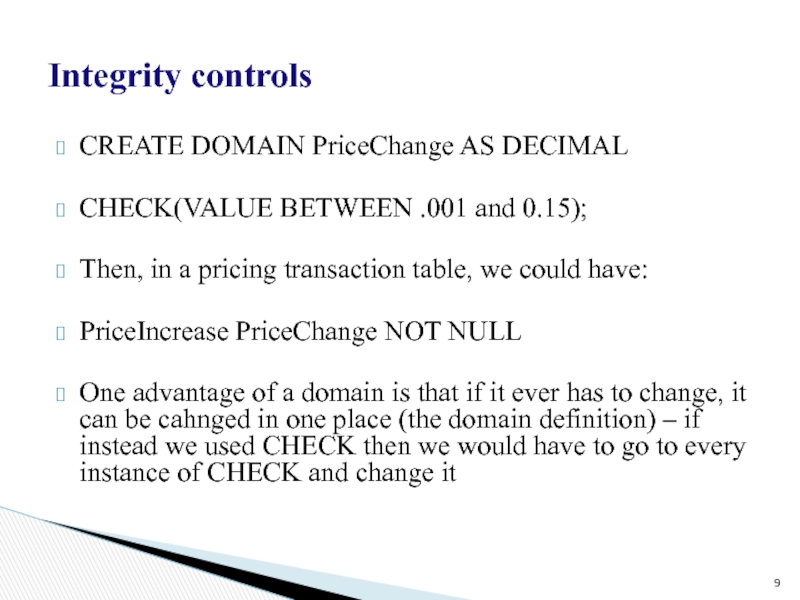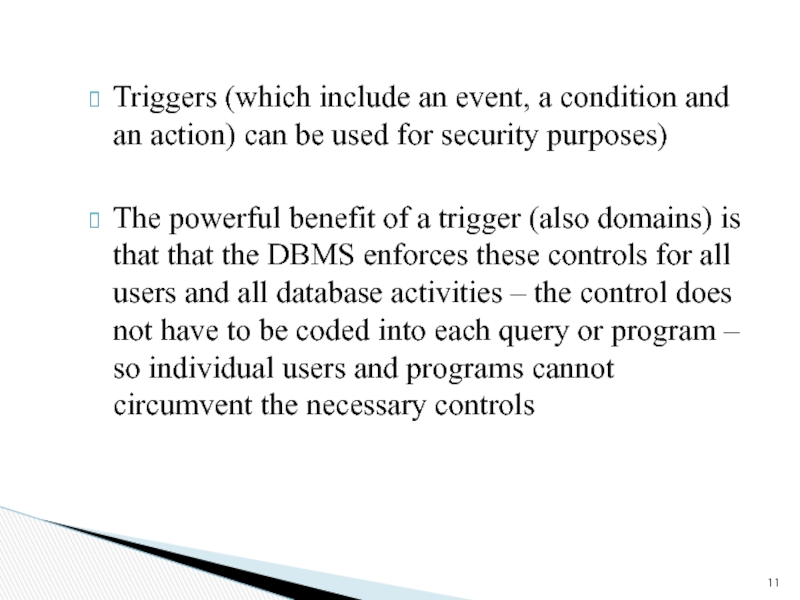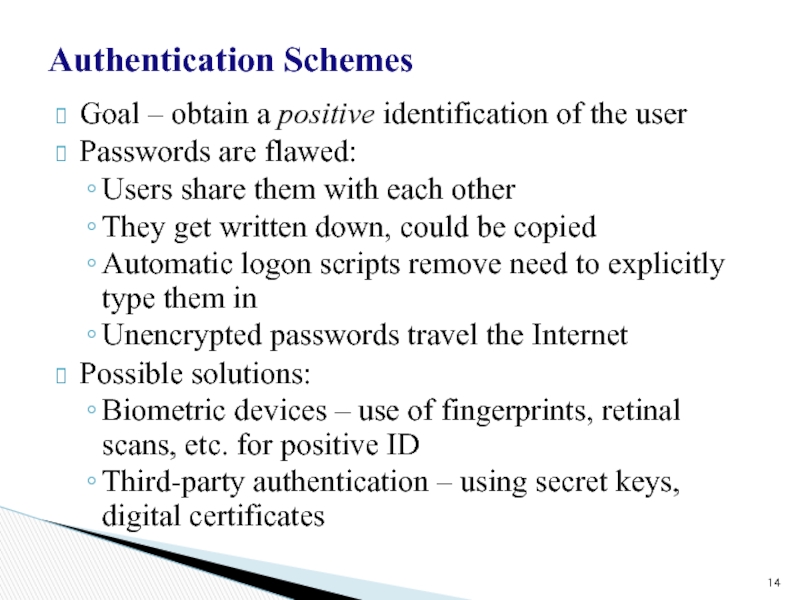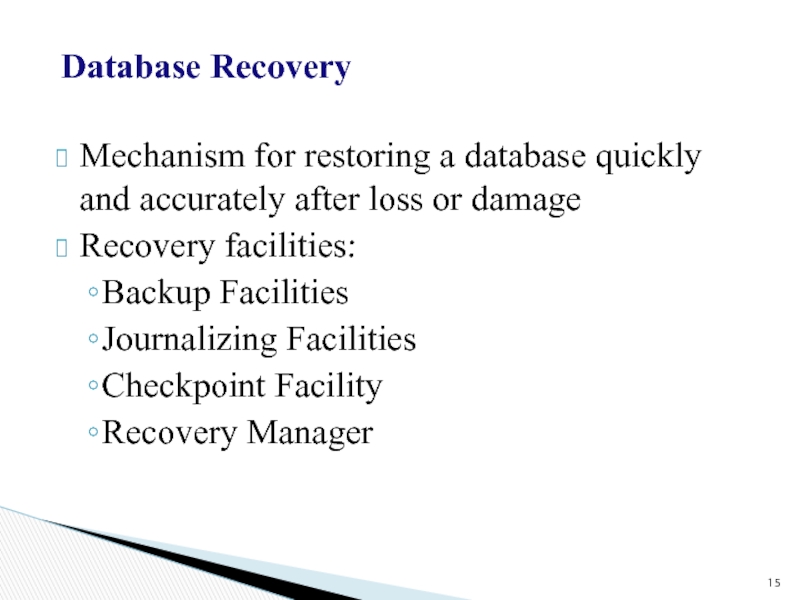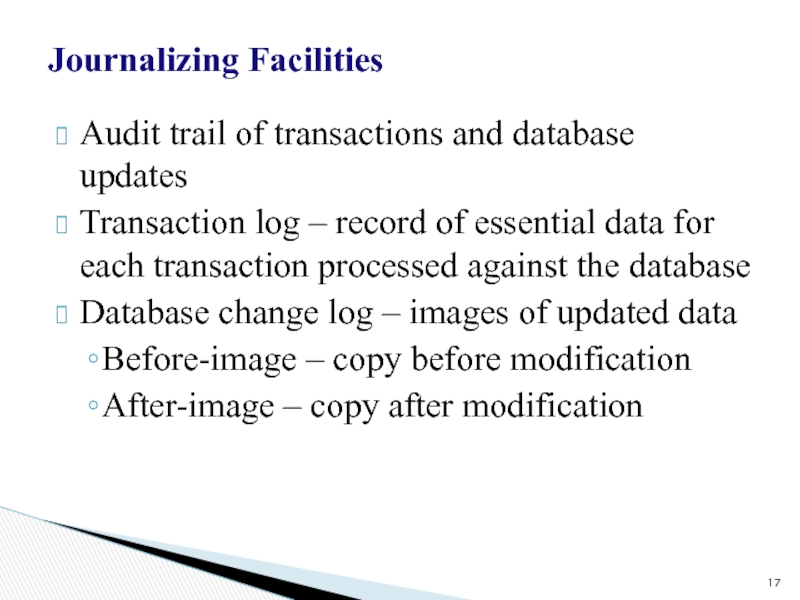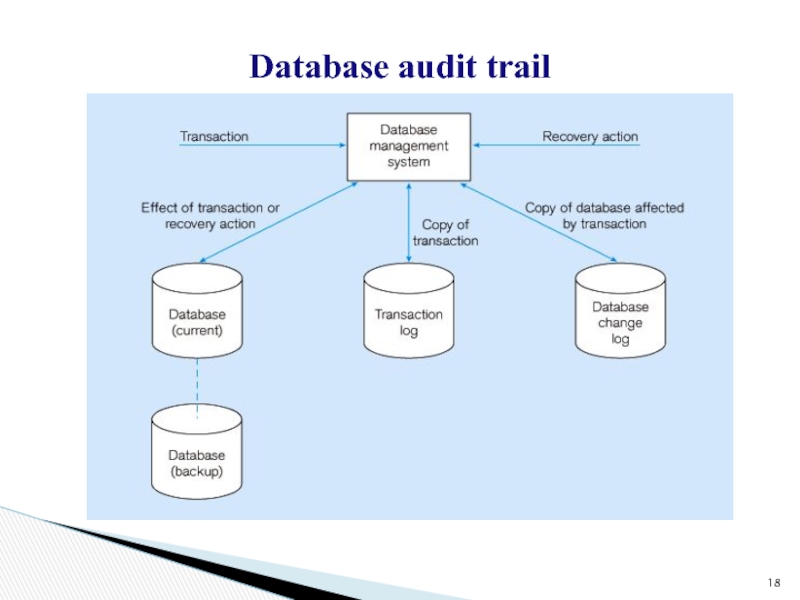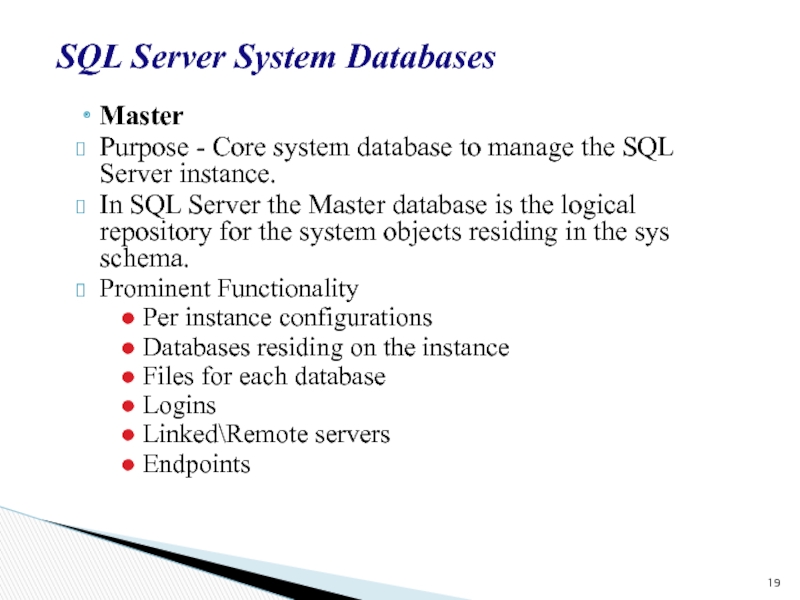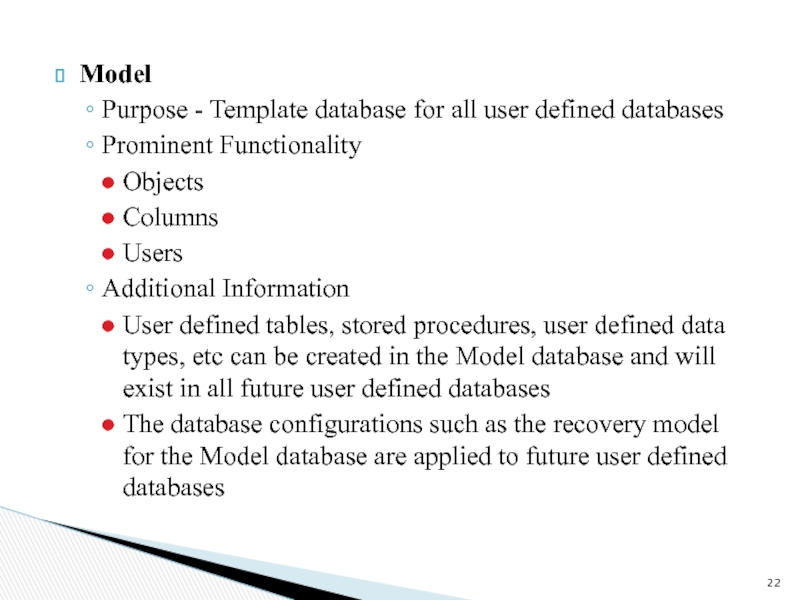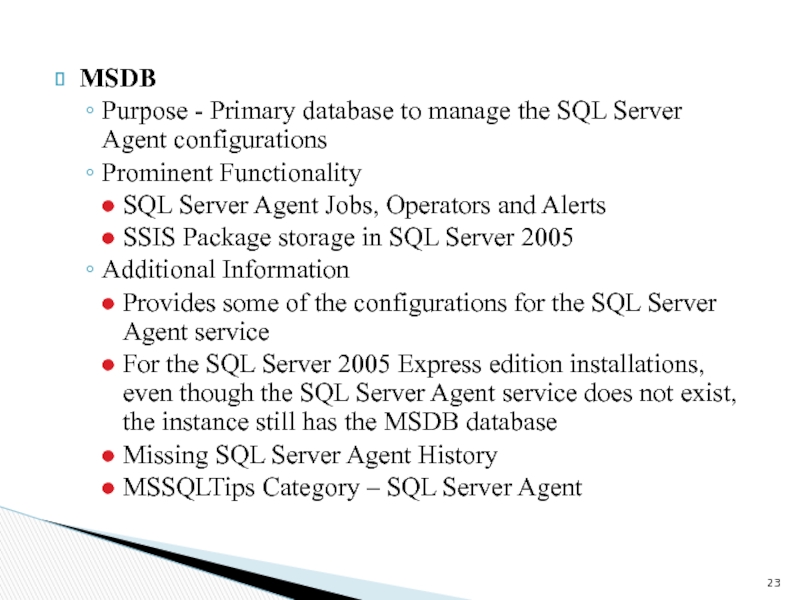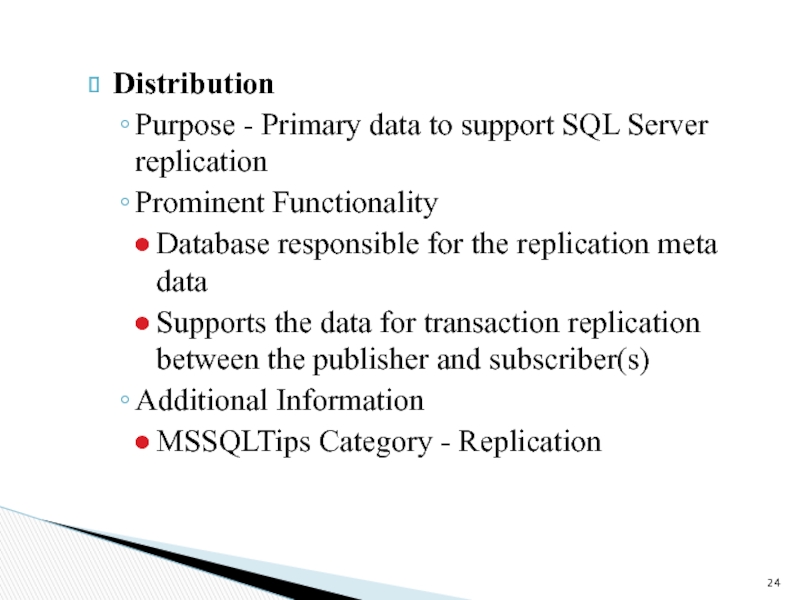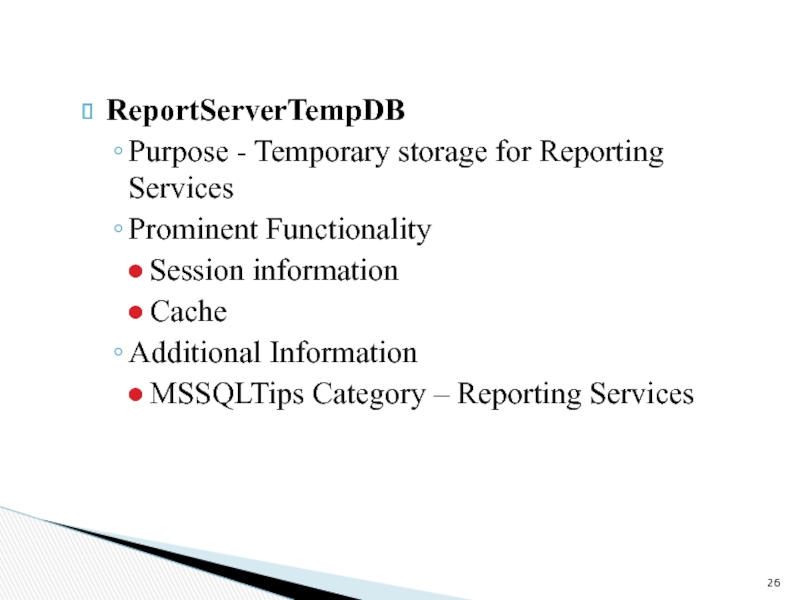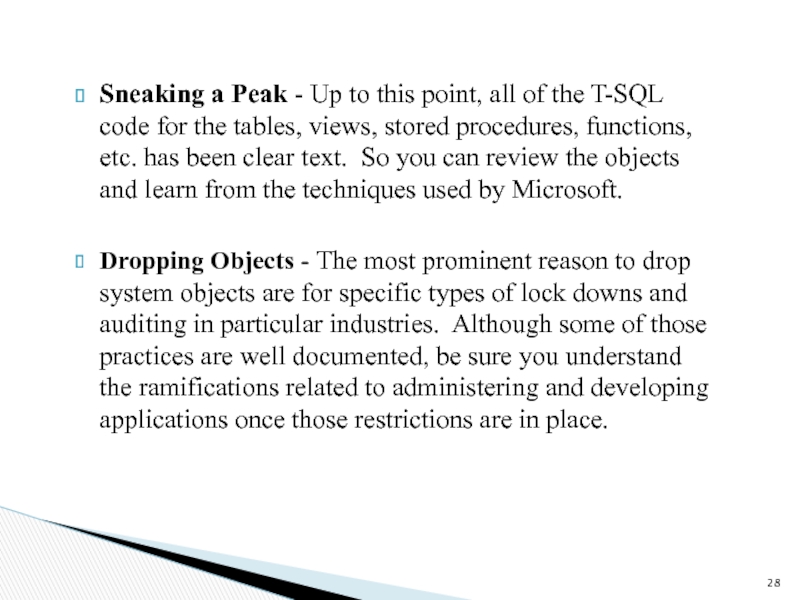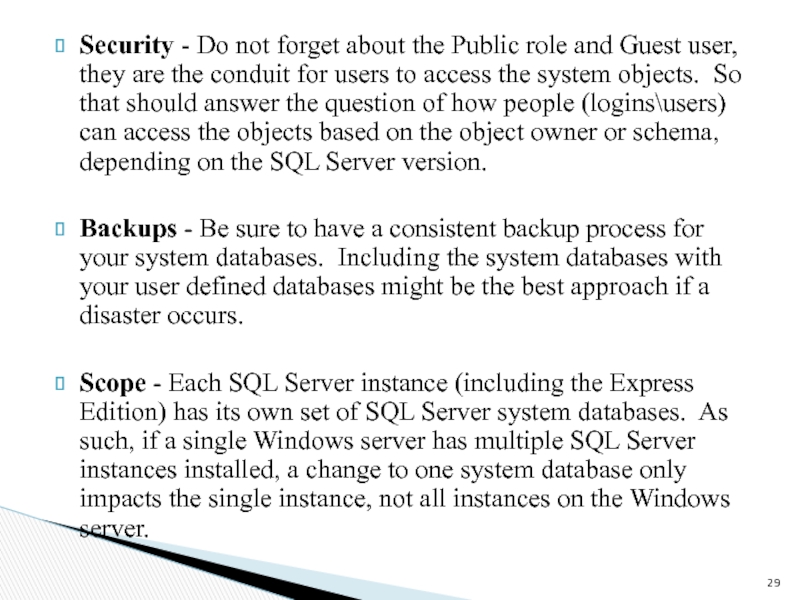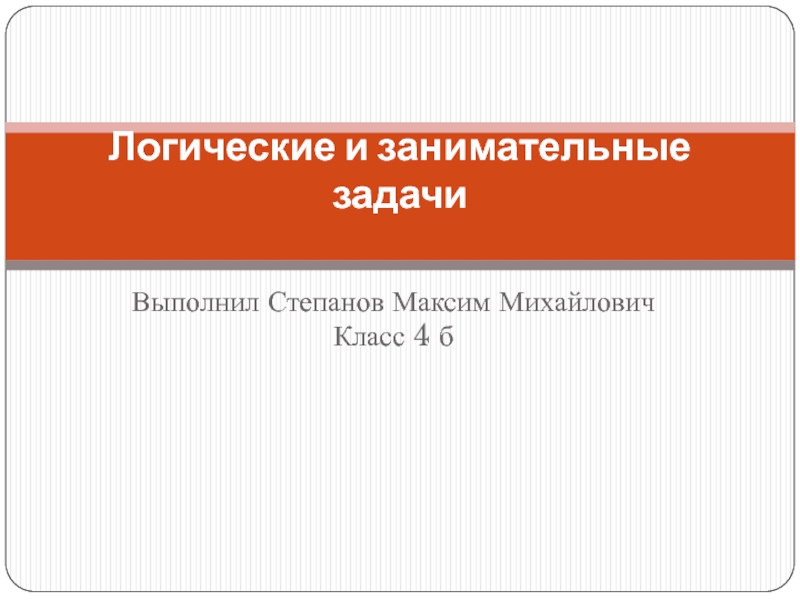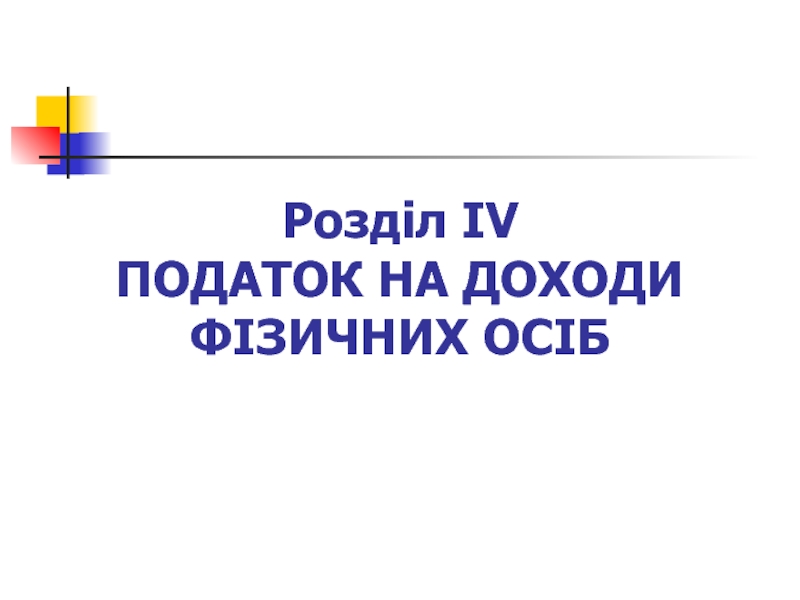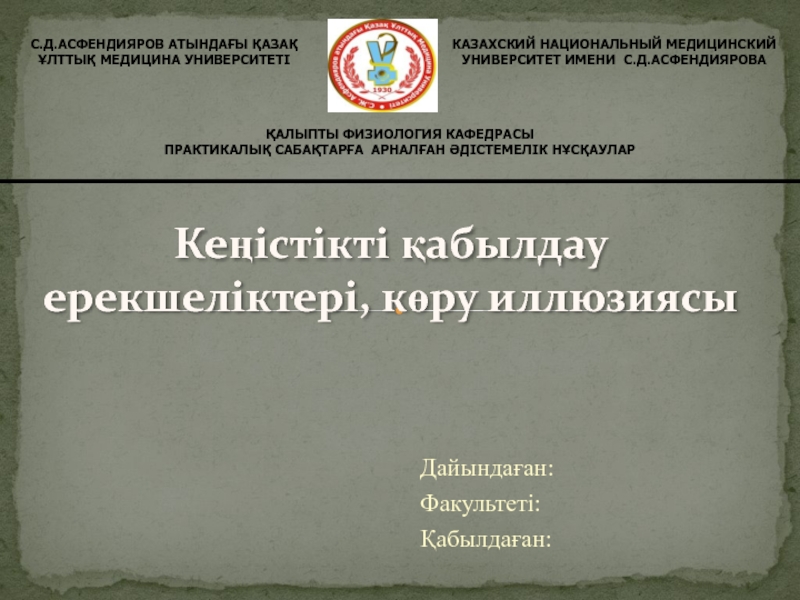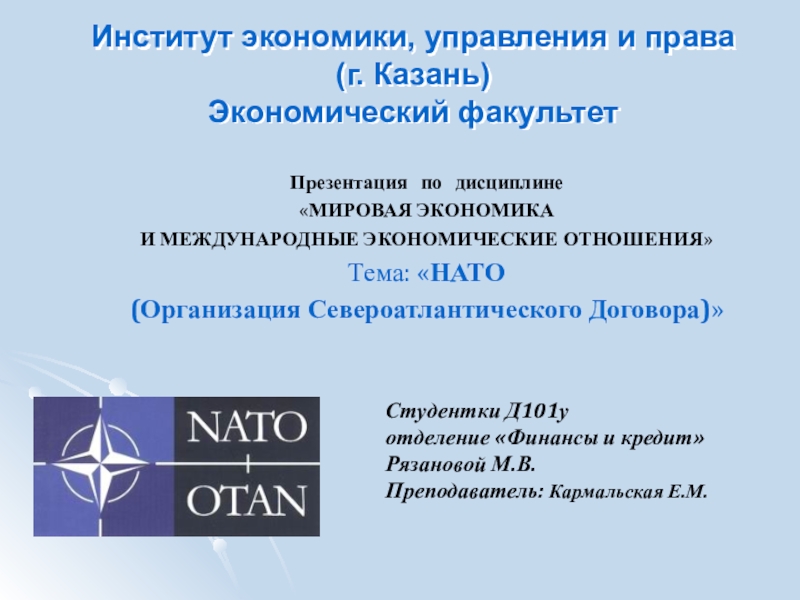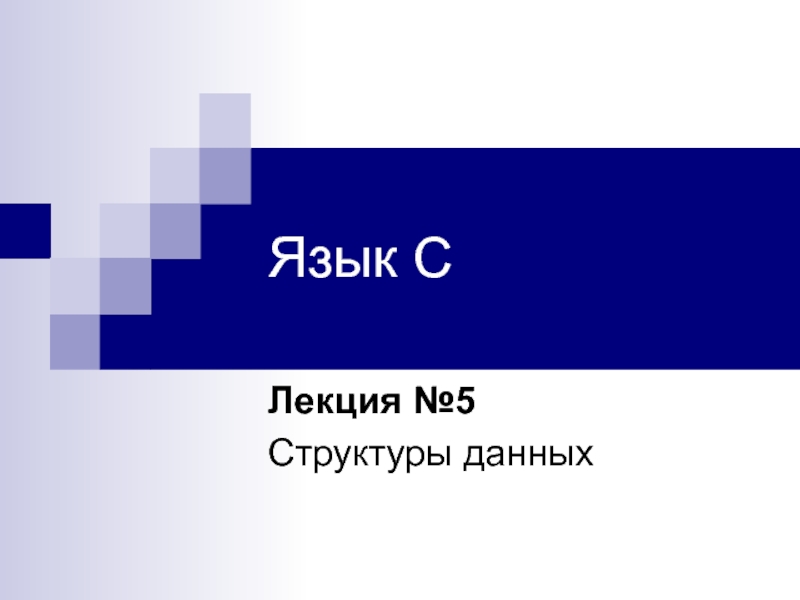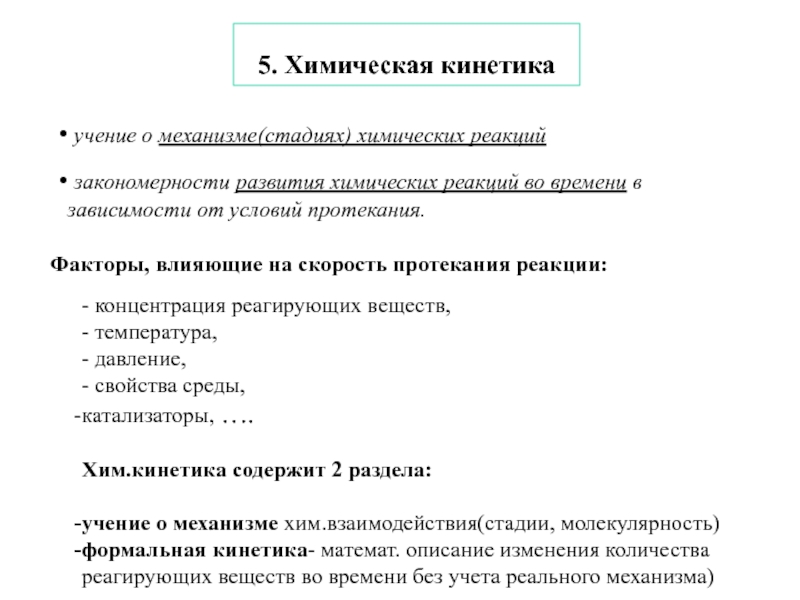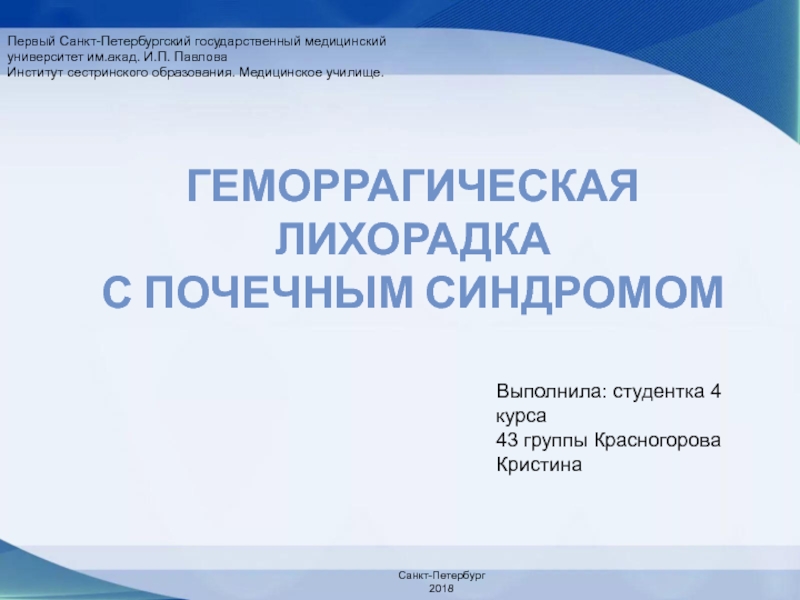Слайд 1
Lectures 1-2
Administration.
Data administration functions
Data warehouse administration
Views
and integrity controls
Authorization rules
Authorisation tables
Authentication Schemes
Database Recovery
Backup Facilities
Journalizing Facilities
Database audit
trail
SQL Server System Databases
Subject: “Database management systems2”
Instructor’s full name: Lyazat Kydyrgalievna Naizabayeva
Слайд 2
Data administration functions
Data policies, procedures, standards
Planning
Data conflict (ownership) resolution
Internal
marketing of DA concepts
Managing the data repository
Selection of hardware and
software
Installing/upgrading DBMS
Tuning database performance
Improving query processing performance
Managing data security, privacy, and integrity
Data backup and recovery
Слайд 3New role, coming with the growth in data warehouses
Similar to
DA/DBA roles
Emphasis on integration and coordination of metadata/data across many
data sources
Specific roles:
Support decision –support applications
Manage data warehouse growth
Establish service level agreements regarding data warehouses and data marts
Data warehouse administration
Слайд 4Database security
Protection of the data against accidental or intentional loss,
destruction, or misuse
Increased difficulty due to Internet access and client/server
technologies
Слайд 5Possible locations of data security threats
Слайд 6Accidental losses - attributable to Human error, software or hardware
failure – tackle using procedures on user authorization, uniform software
installation procedures, hardware maintenance schedules
Theft and fraud – attention should be focussed on all the locations in the previous Fig. (control of physical access, firewalls etc.)
Loss of privacy (personal data) and loss of confidentiality (corporate data)
Loss of data integrity – invalid/corrupt data – need established backup/recovery procedures
Loss of availability (through, e.g. sabotage)
Threats to data security can come from:
Слайд 7Data management software should have these security features:
Views or subschemas
which restrict user views of the database (discussed previously)
Integrity controls
which are enforced by the DBMS during querying and updating
Authorization rules identifying users and restricting actions they can take
User-defined procedures defining additional constraints
Encryption procedures for encoding data in an unrecognisable form
Backup, journalizing, and checkpointing capabilities which facilitate recovery procedures
Слайд 8Views and integrity controls
Views - subset of the database that
is presented to one or more users -user can be
given access privilege to view without allowing access privilege to underlying tables
Integrity Controls - protect data from unauthorized use
One type = Domain – create a user-defined data type and set allowable values. E.g. the PriceChangeDomain can be used as the datatype in any database field (such as PriceIncrease and PriceDiscount) to limit the amount prices can be changed in one transaction:
Слайд 9Integrity controls
CREATE DOMAIN PriceChange AS DECIMAL
CHECK(VALUE BETWEEN .001 and
0.15);
Then, in a pricing transaction table, we could have:
PriceIncrease PriceChange
NOT NULL
One advantage of a domain is that if it ever has to change, it can be cahnged in one place (the domain definition) – if instead we used CHECK then we would have to go to every instance of CHECK and change it
Слайд 10Assertions are constraints enforcing desirable database conditions – they are
checked automatically by the DBMS when transactions are run involving
tables or fields on which assertions exist. E.g., assume that an EMPLOYEE table has fields of Emp_ID, Emp_Name, Supervisor_ID and Spouse_ID, and that a company rule is that no employee may supervise his or her spouse:
CREATE ASSERTION SpousalSupervision
CHECK (SupervisorID < > SpouseID)
Слайд 11Triggers (which include an event, a condition and an action)
can be used for security purposes)
The powerful benefit of a
trigger (also domains) is that that the DBMS enforces these controls for all users and all database activities – the control does not have to be coded into each query or program – so individual users and programs cannot circumvent the necessary controls
Слайд 12Authorization rules
Are controls incorporated in the data management system that
restrict access to data and actions that people can take
on data
Authorization matrix includes subjects, objects, actions and constraints
Each row of the table indicates that a particular subject is authorised to take a certain action on an object in the database (perhaps subject to some constraint)
Following fig shows authorisation matrix where anyone in the Sales Department can insert a new customer record into the database, providing the credit limit does not exceed $5000
Слайд 13Authorisation tables
Many DBMS do not implement authorisation matrices but used
simplified versions – two types – authorisation tables for subjects
and authorisation tables for objects.
In the table for subjects, we can see that salespersons are allowed to modify customer records but not delete those records
In the table for objects, we can see that users in Order Entry or Accounting can modify order records, but salespersons cannot
Слайд 14Authentication Schemes
Goal – obtain a positive identification of the user
Passwords
are flawed:
Users share them with each other
They get written down,
could be copied
Automatic logon scripts remove need to explicitly type them in
Unencrypted passwords travel the Internet
Possible solutions:
Biometric devices – use of fingerprints, retinal scans, etc. for positive ID
Third-party authentication – using secret keys, digital certificates
Слайд 15Database Recovery
Mechanism for restoring a database quickly and accurately after
loss or damage
Recovery facilities:
Backup Facilities
Journalizing Facilities
Checkpoint Facility
Recovery Manager
Слайд 16Backup Facilities
Automatic dump facility that produces backup copy of the
entire database
Periodic backup (e.g. nightly, weekly)
Cold backup – database is
shut down during backup
Hot backup – selected portion is shut down and backed up at a given time
Backups stored in secure, off-site location
Слайд 17Journalizing Facilities
Audit trail of transactions and database updates
Transaction log –
record of essential data for each transaction processed against the
database
Database change log – images of updated data
Before-image – copy before modification
After-image – copy after modification
Слайд 19 SQL Server System Databases
Master
Purpose - Core system database
to manage the SQL Server instance.
In SQL Server the
Master database is the logical repository for the system objects residing in the sys schema.
Prominent Functionality
Per instance configurations
Databases residing on the instance
Files for each database
Logins
Linked\Remote servers
Endpoints
Слайд 20Resource
Purpose - The Resource database is responsible
for physically storing all of the SQL Server 2005 system
objects. This database has been created to improve the upgrade and rollback of SQL Server system objects with the ability to overwrite only this database.
Prominent Functionality
System object definition
Additional Information
Introduced in SQL Server 2005 to help manage the upgrade and rollback of system objects
Prior to SQL Server 2005 the system related data was stored in the master database
Read-only database that is not accessible via the SQL Server 2005 tool set
The Resource database does not have an entry in master.sys.databases
Слайд 21TempDB
Purpose - Temporary database to store temporary tables (#temptable
or ##temptale), table variables, cursors, work tables, row versioning, create
or rebuild indexes sorted in TempDB, etc. Each time the SQL Server instance is restarted all objects in this database are destroyed, so permanent objects cannot be created in this database.
Prominent Functionality
Manage temporary objects listed in the purpose above
Additional Information
Each time a SQL Server instance is rebooted, the TempDB database is reset to its original state
Слайд 22Model
Purpose - Template database for all user defined databases
Prominent Functionality
Objects
Columns
Users
Additional Information
User defined tables, stored
procedures, user defined data types, etc can be created in the Model database and will exist in all future user defined databases
The database configurations such as the recovery model for the Model database are applied to future user defined databases
Слайд 23MSDB
Purpose - Primary database to manage the SQL Server
Agent configurations
Prominent Functionality
SQL Server Agent Jobs, Operators and
Alerts
SSIS Package storage in SQL Server 2005
Additional Information
Provides some of the configurations for the SQL Server Agent service
For the SQL Server 2005 Express edition installations, even though the SQL Server Agent service does not exist, the instance still has the MSDB database
Missing SQL Server Agent History
MSSQLTips Category – SQL Server Agent
Слайд 24Distribution
Purpose - Primary data to support SQL Server replication
Prominent Functionality
Database responsible for the replication meta data
Supports
the data for transaction replication between the publisher and subscriber(s)
Additional Information
MSSQLTips Category - Replication
Слайд 25ReportServer
Purpose - Primary database for Reporting Services to store
the meta data and object definitions
Prominent Functionality
Reports security
Job schedules and running jobs
Report notifications
Report execution history
Additional Information
MSSQLTips Category – Reporting Services
Слайд 26ReportServerTempDB
Purpose - Temporary storage for Reporting Services
Prominent Functionality
Session information
Cache
Additional Information
MSSQLTips Category – Reporting Services
Слайд 27System Databases Do's and Don'ts
Data Access - Based on
the version of SQL Server query only the recommended objects.
In general the system database objects are being deprecated to a set of views, so be sure all of your scripts are accessing the right objects. If not, you are going to have a big project in the future to convert all of your scripts.
Changing Objects - Do not change system objects. In SQL Server 2005 all of the database objects have been moved to the Resource database which stores the definition for the system objects and can be updated via new SQL Server releases independent of the data.
New Objects - Creating objects in the system databases is not recommended. If you have objects that are needed for the instance i.e. administrative items, just create a separate DBA database to store these objects.
Слайд 28Sneaking a Peak - Up to this point, all of
the T-SQL code for the tables, views, stored procedures, functions,
etc. has been clear text. So you can review the objects and learn from the techniques used by Microsoft.
Dropping Objects - The most prominent reason to drop system objects are for specific types of lock downs and auditing in particular industries. Although some of those practices are well documented, be sure you understand the ramifications related to administering and developing applications once those restrictions are in place.
Слайд 29Security - Do not forget about the Public role and
Guest user, they are the conduit for users to access
the system objects. So that should answer the question of how people (logins\users) can access the objects based on the object owner or schema, depending on the SQL Server version.
Backups - Be sure to have a consistent backup process for your system databases. Including the system databases with your user defined databases might be the best approach if a disaster occurs.
Scope - Each SQL Server instance (including the Express Edition) has its own set of SQL Server system databases. As such, if a single Windows server has multiple SQL Server instances installed, a change to one system database only impacts the single instance, not all instances on the Windows server.
